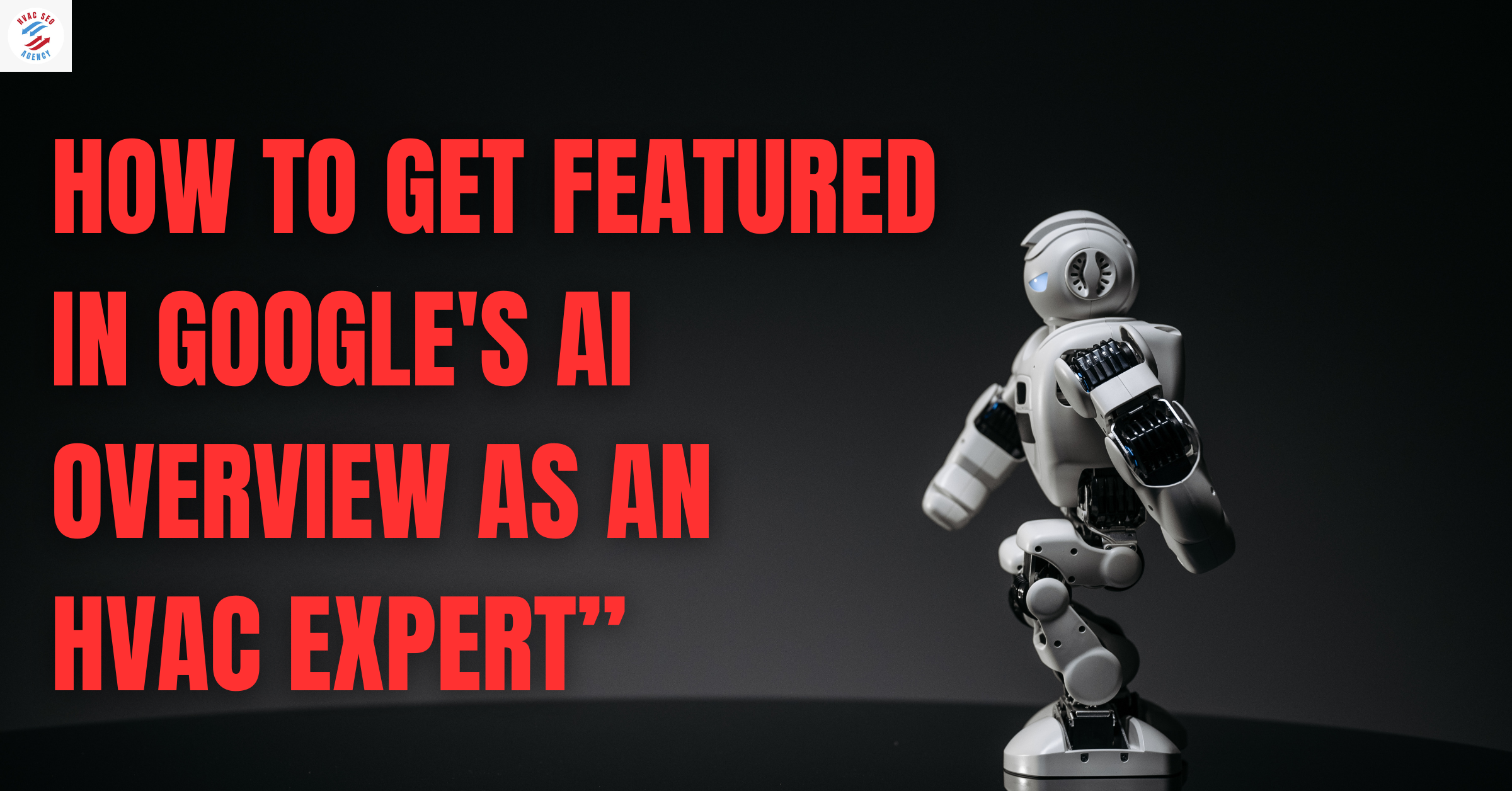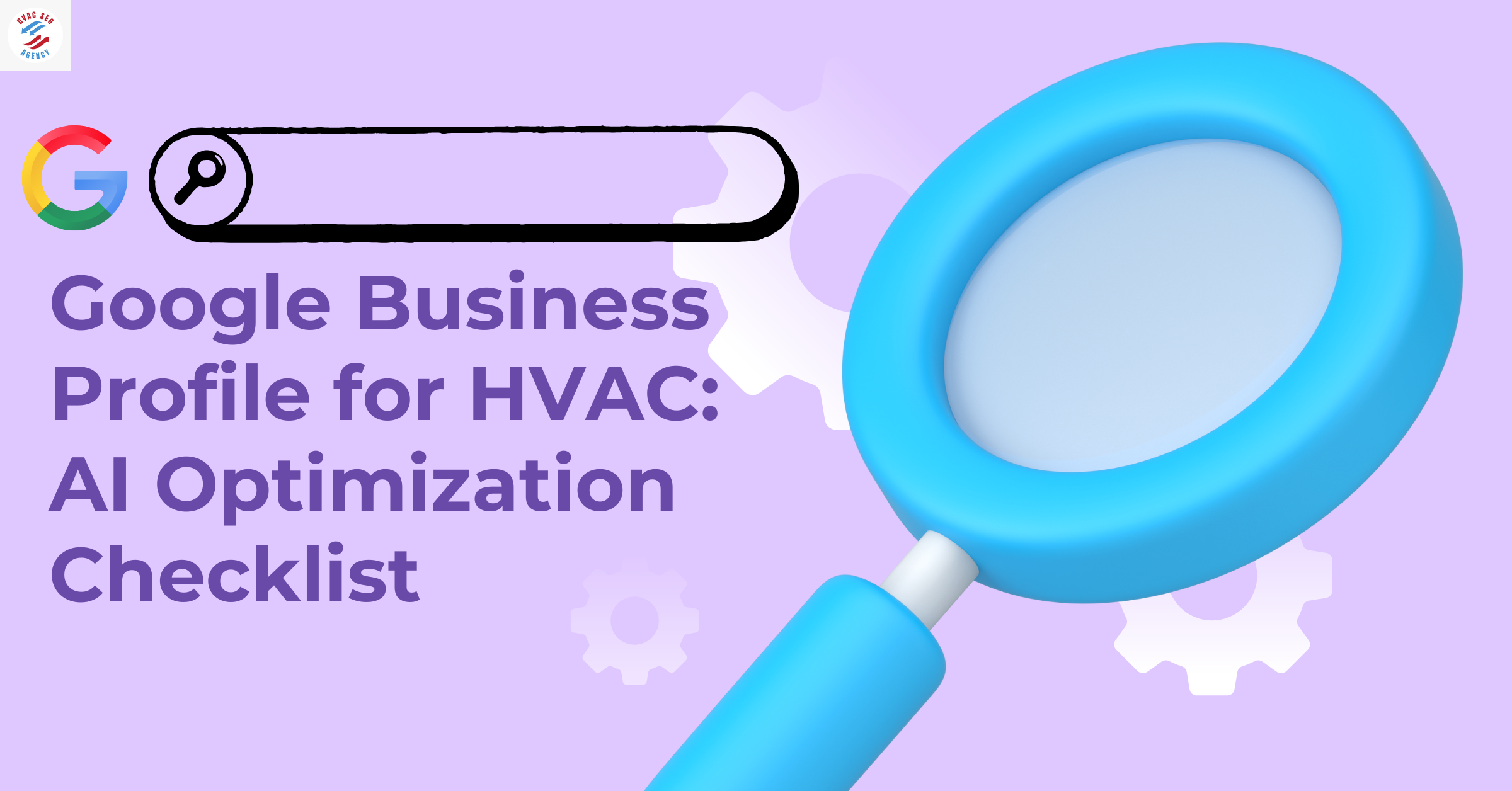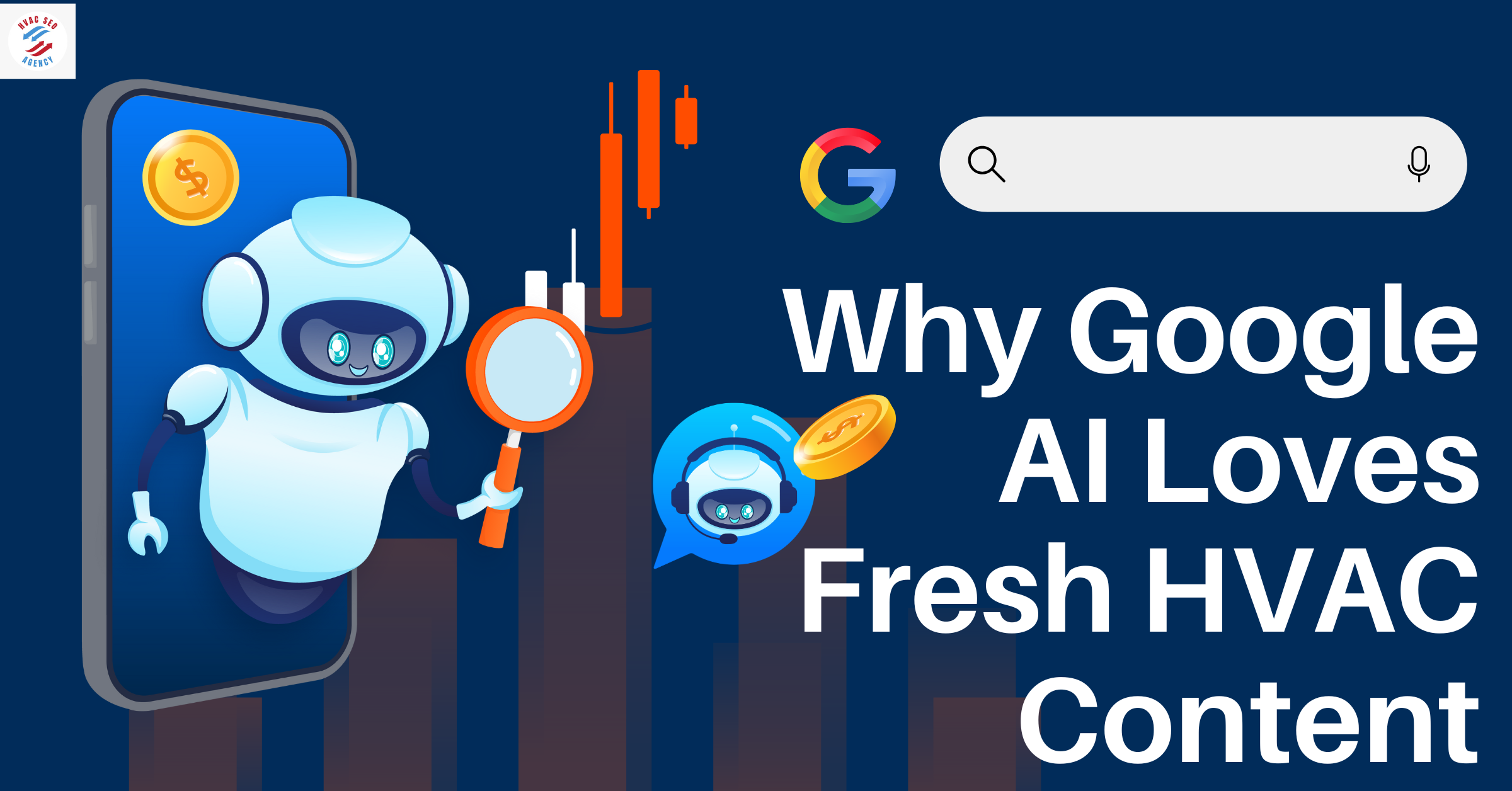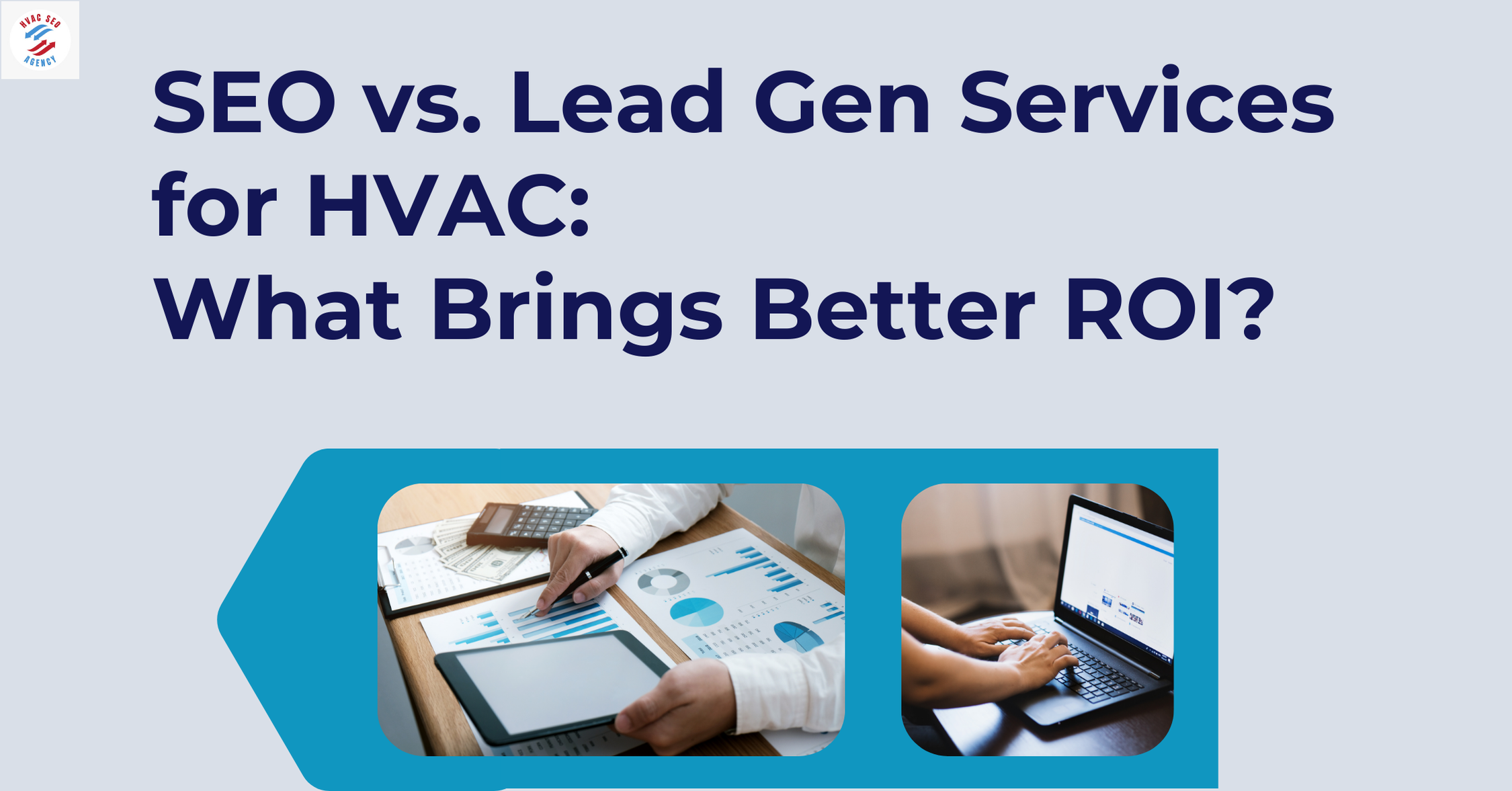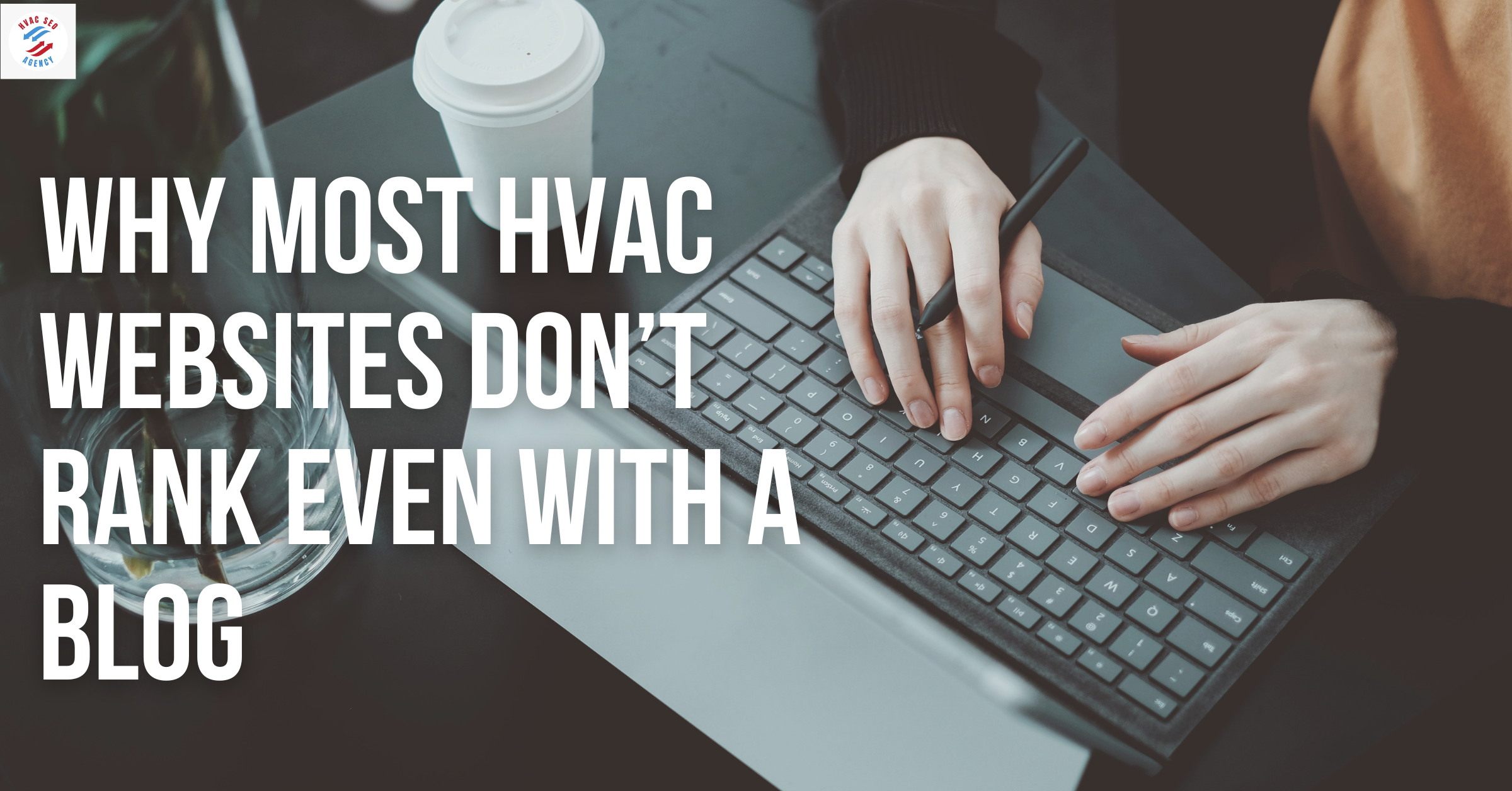How to Dominate Local HVAC Search Rankings
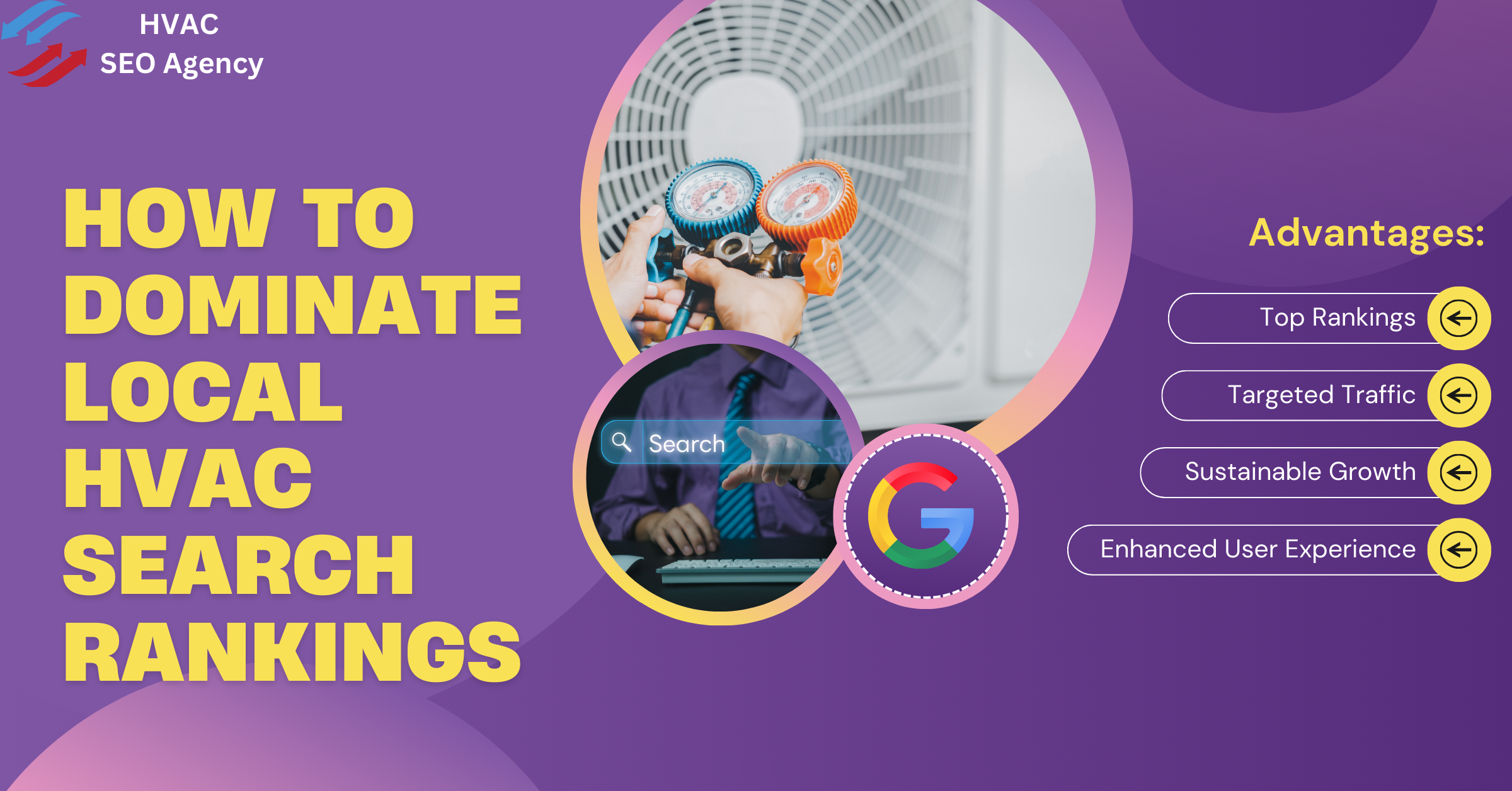
In the competitive HVAC industry, ranking high in local search results can make all the difference in attracting customers. One of the most effective ways to improve visibility and increase leads is by optimizing your Google Business Profile (GBP). GBP is a free yet powerful tool that helps HVAC businesses appear in Google’s Local Pack, Google Maps, and organic search results, ensuring they reach potential customers actively searching for HVAC services.
A well-optimized GBP enhances online presence, builds trust, and improves local search rankings. With nearly half of all Google searches having local intent, HVAC businesses that do not optimize their GBP risk losing valuable customers to competitors. Partnering with an affordable HVAC SEO agency can streamline this process, ensuring your business gets maximum exposure with the right local SEO strategies.
This guide provides a step-by-step approach to GBP optimization, helping your HVAC company stand out, attract more local leads, and improve search engine rankings for long-term success.
Local HVAC Search Trends & Customer Behavior
A properly optimized Google Business Profile can significantly impact how your HVAC company ranks in local searches. Here are some key reasons why optimizing your GBP is essential:
46 percent of all Google searches are local – meaning users are actively searching for HVAC services near them.
Businesses with a fully optimized GBP get 7 times more clicks than those with incomplete profiles.
76 percent of local searches result in a call or visit within 24 hours.
A well-optimized GBP helps HVAC businesses rank higher, increasing visibility and driving local leads.
Without proper GBP optimization, your HVAC company may struggle to appear in Google’s Map Pack, which is a critical factor for local SEO success.
Step-by-Step Guide to Optimize Your GBP for HVAC SEO
Claim and Verify Your Business
To start optimizing your GBP, you must first claim and verify your business:
Visit the Google Business Profile Manager and search for your HVAC company.
If your business is not listed, create a new profile and fill in all relevant details.
Select the most accurate business categories, such as:
HVAC contractor
Air conditioning repair service
Heating and cooling contractor
Verify your business through phone, email, or postcard to activate your listing.
Claiming and verifying your GBP is the first step toward building credibility and improving local search visibility.
Use High-Intent Keywords in Your Business Description
Your business description is a crucial component of GBP optimization. It should naturally incorporate primary and secondary HVAC-related keywords to enhance visibility in local searches.
Here is an example of an SEO-optimized business description:
"Looking for reliable HVAC services? Our company specializes in [HVAC repair and installation] with expert technicians who provide high-quality AC repair, heating installation, and duct cleaning services. We follow the best [local HVAC SEO strategy] to help homeowners and businesses stay comfortable year-round. Contact us today for professional [HVAC system maintenance] and emergency repair services."
Tips for optimizing your GBP business description:
Use primary keywords like "HVAC repair," "AC installation," and "heating services" at least five to six times.
Highlight unique selling points (24/7 service, licensed technicians, financing options).
Maintain a natural, engaging, and customer-focused tone.
Add High-Quality Geo-Tagged Images & Videos
Visual content plays a vital role in GBP optimization. Businesses that include high-quality images and videos experience 42 percent more clicks than those without.
Here are the types of images you should upload:
Company branding – Photos of your office, service vehicles, and team members wearing branded uniforms.
Before-and-after images – Showcase HVAC repairs, installations, and duct cleaning.
Action shots – Technicians performing HVAC maintenance and repairs.
Using video content is also an excellent way to improve customer engagement. Upload short, high-quality videos that include:
Customer testimonials
Behind-the-scenes HVAC service footage
Quick maintenance tips for homeowners
Additionally, using geo-tagged images and videos helps Google associate your business with specific locations, further boosting your rankings in local searches.
Enable Google Q&A to Answer Customer Queries
Google allows customers to ask questions directly on your GBP listing. Proactively answering these questions can improve your engagement rate and build trust with potential clients.
Best practices for managing Google Q&A:
Pre-fill common questions with detailed answers to improve customer experience.
Encourage satisfied customers to ask questions and interact with your responses.
Monitor and update your answers regularly using Local SEO Tips for HVAC Contractors to Boost Google Rankings, ensuring accurate and up-to-date information.
Encourage & Respond to Customer Reviews
Customer reviews are a major ranking factor in local SEO. The more high-quality reviews your business receives, the better it ranks in Google’s Local Pack.
Best practices for GBP reviews:
Politely ask satisfied customers to leave a review after service completion.
Offer small incentives (discounts on future services) to encourage more reviews.
Respond to every review – whether positive or negative – in a professional and courteous manner.
Use keywords in your review responses to reinforce local SEO signals.
Example response to a positive review:
"Thank you, [customer name], for your kind words! We’re glad our HVAC team could help with your AC installation. If you ever need maintenance or repairs, don’t hesitate to reach out!"
Impact of GBP Optimization on Local HVAC SEO
GBP optimization factors have a direct impact on local search rankings. Below is a breakdown of key factors that influence HVAC SEO rankings:
(I will include a graphical representation here when finalizing the complete blog.)
Final Thoughts
Optimizing your Google Business Profile (GBP) is essential for dominating local HVAC search rankings. By following the steps outlined in this guide, HVAC businesses can increase visibility, generate more local leads, and improve customer trust.
GBP optimization is an ongoing process. Regularly updating your profile with new photos, customer reviews, and fresh content ensures your business remains competitive in the ever-evolving local SEO landscape.
By leveraging GBP optimization, your HVAC company can stand out in Google’s Map Pack, attract more customers, and drive sustainable business growth.
The Power of Local Keyword Research for HVAC SEO
Keyword research is the foundation of a successful HVAC local SEO strategy. Choosing the right keywords ensures that your business appears in search results when potential customers are actively looking for heating, ventilation, and air conditioning services. By focusing on high-intent local keywords, you can improve your rankings, attract qualified leads, and increase conversions.
Many HVAC businesses struggle to get noticed in competitive local markets because they fail to use the right keywords. With over 70 percent of consumers searching for local HVAC services using keywords like "AC repair near me", your business must strategically optimize for these searches.
This guide covers why local keyword research is critical, how to find high-converting HVAC keywords, and where to use them for maximum impact.
Generic vs. Local Keywords - Impact on HVAC Lead Generation
Local keyword optimization plays a crucial role in attracting potential customers who are ready to hire an HVAC service provider. Here’s why your business must prioritize local HVAC keywords:
70 percent of consumers use local keywords like “HVAC repair near me” before making a hiring decision.
High-intent local keywords convert 4 times more than generic keywords because they target users actively looking for services.
Voice search queries for HVAC services have increased by 30 percent year-over-year, making long-tail keywords crucial for local SEO.
Optimizing for local HVAC SEO Agency ensures your business appears in Google’s Local Pack, increasing your visibility to customers in your service area.
Unlike broad keywords, local HVAC keywords attract customers who need immediate service, making them more valuable for businesses looking to boost local traffic and conversions.
Best Local HVAC Keywords to Target
Selecting the right local keywords depends on the intent behind the search. Below is a breakdown of different keyword types and how they influence customer behavior:
Pro Tip:
Transactional keywords generate faster leads because they target customers who need an immediate solution.
Informational keywords build brand trust and increase long-term visibility by positioning your business as an industry expert.
To dominate local search results, HVAC businesses should use a mix of transactional, commercial, and informational keywords in their SEO strategy.
How to Find High-Intent HVAC Keywords
Identifying the best local HVAC keywords requires research using SEO tools and real-world customer insights. Below are some of the best ways to find high-intent keywords:
Google’s Keyword Planner
A free tool that provides search volume, competition, and cost-per-click (CPC) data.
Helps identify low-competition, high-volume local keywords for HVAC services.
Answer The Public
Ideal for finding commonly asked HVAC-related questions that users search for online.
Generates long-tail keywords and FAQ-style content ideas that can rank for voice searches.
SEMrush & Ahrefs
Advanced SEO tools for keyword difficulty analysis and competitor research.
Allows you to see which keywords your competitors rank for and identify gaps in your SEO strategy.
By using these tools, HVAC companies can discover valuable local keywords, optimize their content, and outperform competitors in local search results.
Where to Use Local Keywords for Maximum Impact
Once you’ve identified the best HVAC keywords, strategically placing them throughout your website and online profiles is essential. Here’s where to use local keywords for maximum SEO benefits:
Website Meta Titles & Descriptions
Ensure primary local keywords appear in title tags and meta descriptions for better click-through rates (CTR).
Example: "Top-Rated HVAC Contractor in [City] | Reliable AC Repair Services Near You."
H1, H2, and H3 Headings
Structure your web pages and blog posts with headings that include high-intent local keywords.
Example: "Emergency HVAC Repair in [City]: 24/7 Service Available."
Service Pages & Blog Content
Each service page should target a specific HVAC keyword for better search rankings.
Write blog content around common HVAC issues and solutions, incorporating long-tail local keywords.
Google Business Profile (GBP)
Add primary and secondary HVAC keywords to your GBP business description.
Optimize your services section with high-intent keywords for local rankings.
Image ALT Tags & URLs
Every image on your website should have ALT text with local keywords to improve image search rankings.
Example: "hvac-contractor-in-[City]-performing-ac-installation.jpg."
By placing local keywords in these critical areas, HVAC businesses can improve organic search visibility and local rankings.
Keyword Strategy Comparison
Using local keywords instead of generic ones significantly improves HVAC local search rankings, lead conversion rates, and search visibility. Below is a comparison of generic vs. local keyword strategies:
This comparison shows that local keywords are easier to rank for, cost-effective, and drive higher conversions compared to generic keywords.
Final Thoughts
Local keyword research is one of the most critical aspects of HVAC SEO. By targeting high-intent local keywords, HVAC businesses can:
Rank higher in local search results
Attract qualified leads who are ready to hire
Optimize for Google's Featured Snippets
Improve conversion rates and local visibility
Investing in local keyword research and optimization ensures sustainable growth and higher customer engagement. By implementing these strategies, HVAC companies can stay ahead of the competition and dominate their local market.
Building Hyperlocal HVAC Service Pages
Creating hyperlocal HVAC service pages is one of the most effective ways to rank higher in Google search results and attract more local leads. A well-optimized local HVAC SEO strategy ensures that your business appears when potential customers search for HVAC services in their specific city, neighborhood, or zip code.
Unlike generic service pages, hyperlocal pages focus on specific geographic areas, making them highly relevant to searchers and increasing conversion rates. Google prioritizes localized search results, so targeting multiple cities and neighborhoods with dedicated pages can significantly improve your HVAC business’s online visibility and lead generation.
This guide outlines the importance of hyperlocal service pages, their key components, and optimization strategies to help your HVAC company rank higher in local search results.
Why Hyperlocal Service Pages Are Essential for HVAC SEO
Hyperlocal service pages are designed to target specific locations, making it easier for potential customers to find your business when searching for HVAC services near them. Here’s why they are critical:
Google prioritizes localized search results for home services like HVAC, meaning businesses that optimize for location-based searches rank higher.
Local SEO to Get More HVAC Service Calls ensures that businesses appear in multiple locations, expanding their service area coverage.
70% of users prefer hiring a company that appears in their city's search results, boosting credibility and trust.
Unlike generic pages, hyperlocal service pages increase relevance by focusing on specific cities, neighborhoods, and zip codes, leading to higher HVAC search rankings and more leads.
By implementing well-optimized hyperlocal pages, HVAC businesses can attract targeted customers actively searching for services in their area.
Elements of a High-Converting HVAC Service Page
A well-structured hyperlocal HVAC service page should include the following essential elements:
City-Specific Keywords
Use geo-targeted HVAC keywords, such as "HVAC repair in [City]" or "AC installation in [Neighborhood]".
Mention nearby landmarks and service areas to improve Google’s location-based rankings.
NAP Consistency (Name, Address, Phone Number)
Ensure consistent business details (NAP) across all service pages, GBP, and directories to boost local trust signals.
Google Map Embed
Adding a Google Map of your HVAC business location increases local SEO rankings and helps potential customers find you easily.
Localized Customer Reviews
Show customer testimonials from specific service areas to build trust and enhance local relevance.
Schema Markup for HVAC Services
Implement Local Business Schema to help Google understand and rank your service pages more effectively.
Example of a High-Performing HVAC Service Page Structure
Write City-Specific Content
To maximize local search visibility, mention:
City names, neighborhoods, and zip codes
Landmarks and surrounding service areas
Local weather conditions affecting HVAC needs
Example:
"Our HVAC technicians provide expert heating and cooling services to homeowners in Downtown Austin, Hyde Park, and South Congress. Whether you need a new AC unit installed or emergency repairs, our local team is ready to help."
Use Customer Testimonials from Local Clients
Including real reviews from customers in different areas boosts social proof and trustworthiness.
Example:
"John from Scottsdale says: ‘The best HVAC repair service near me! The technician arrived within an hour and fixed my AC unit quickly.’"
Ensure Schema Markup is Implemented
Adding structured data markup (Schema) helps Google rank your HVAC service pages for local searches.
Example of Local Business Schema Markup
json
CopyEdit
{
"@context": "https://schema.org",
"@type": "HVACBusiness",
"name": "Phoenix HVAC Experts",
"address": {
"@type": "PostalAddress",
"addressLocality": "Phoenix",
"addressRegion": "AZ",
"postalCode": "85001"
},
"telephone": "+1-800-555-1234",
"url": "https://www.phoenixhvacexperts.com"
}
Add Location-Specific Calls-to-Action (CTAs)
Every hyperlocal service page should include city-specific CTAs to drive conversions.
Examples of Location-Based CTAs:
"Call now for 24/7 AC repair in [City]!"
"Get a free HVAC consultation in [Neighborhood]."
"Book a same-day AC inspection in [Zip Code]."
By optimizing service pages with clear, location-based CTAs, HVAC companies can increase engagement and conversion rates.
Generic vs. Hyperlocal HVAC Service Pages
Final Thoughts
Implementing hyperlocal HVAC service pages is one of the best ways to improve local search rankings, attract more qualified leads, and increase conversions. By optimizing each page with city-specific keywords, customer testimonials, schema markup, and local content, HVAC businesses can:
Rank higher in multiple service areas
Increase lead generation and customer inquiries
Improve credibility with Google and potential customers
Drive more local business growth and revenue
For HVAC companies looking to expand their reach, hyperlocal SEO strategies are essential for long-term success in competitive markets.
Local Backlinks & Off-Page SEO for HVAC Businesses
Backlinks continue to be one of the most powerful ranking factors for HVAC local SEO. Google places a high level of trust in websites with strong local citations and authoritative backlinks, making off-page SEO a critical component of any successful HVAC SEO strategy.
By securing high-quality local backlinks, HVAC businesses can improve their domain authority, rank higher in local search results, and attract more potential customers. A strategic link-building approach that includes local directories, partnerships, press releases, and guest posting can significantly enhance search visibility and credibility.
This guide covers the importance of backlinks, the best link-building strategies, and how HVAC companies can track and improve their backlink profile for long-term SEO success.
Impact of Local Backlinks on HVAC SEO Rankings
Google uses backlinks as a ranking factor because they act as votes of confidence from other websites. The more authoritative sites link to your HVAC business, the higher Google ranks your website in search results.
Key Benefits of Backlinks for HVAC SEO:
Backlinks remain a major Google ranking factor, influencing organic search performance.
High-quality local backlinks help HVAC companies rank higher in Google’s Local Pack and Maps.
88% of top-ranking HVAC websites have backlinks from authoritative local directories.
Backlinks improve HVAC businesses' credibility, making them more trustworthy in Google’s eyes.
A strong backlink profile is essential for beating competitors in local search rankings and generating more inbound leads.
Best Local Link-Building Strategies for HVAC Businesses
Building a high-quality backlink profile requires strategic link acquisition from trusted local sources. Below are the best link-building techniques HVAC businesses can use:
Get Listed in Local HVAC Directories
Online directories serve as authoritative citations that help Google verify your business information. Submitting your HVAC company to high-authority local directories strengthens your off-page SEO and improves your local rankings.
Must-Have Directories for HVAC Businesses:
Why It Matters:
These high DA directories enhance Google’s trust in your business.
Ensuring NAP (Name, Address, Phone Number) consistency across all listings improves local search rankings.
Customers actively search for HVAC services on these platforms, leading to higher engagement.
Earn Links from Local Partnerships & Sponsorships
Partnering with local businesses and organizations is an excellent way to earn high-quality backlinks while increasing brand awareness.
How to Get Local Partnership Links:
Sponsor community events, such as "Free AC Tune-Up for Senior Citizens".
Form partnerships with home service businesses, such as electricians, plumbers, and realtors, for reciprocal links.
Offer discounts to local businesses in exchange for a feature on their website.
Guest Posting on Home Improvement & HVAC Blogs
Writing guest articles for authoritative home improvement, construction, and energy efficiency blogs can help increase backlinks and brand exposure.
Example Guest Post Topics:
"The Top 5 Ways to Reduce Your Energy Bill This Summer"
"How to Maintain Your HVAC System for Maximum Efficiency"
"The Benefits of Smart Thermostats for Homeowners"
Why Guest Posting Works:
Establishes your HVAC business as an authority in the industry.
Earns high-quality, relevant backlinks from trusted blogs.
Drives referral traffic from readers actively searching for HVAC advice.
Leverage Local News & Press Releases
Getting featured in local news articles and industry press releases can help boost local search rankings while improving brand trust and visibility.
Best Practices for HVAC Press Releases:
Announce new HVAC service expansions in different cities.
Share energy-efficient HVAC technology updates or special promotions.
Publish stories on community involvement, such as free AC repair events for low-income families.
Distribute press releases through PR services like PRWeb or Newswire to gain local media coverage.
How to Track & Improve Your Backlink Profile
Building a strong backlink profile requires consistent monitoring and improvement. Below are the best ways to track and enhance your HVAC backlink strategy:
Use Google Search Console to Monitor Indexed Backlinks
Google Search Console allows HVAC businesses to see which sites link to them and track indexing issues.
Regularly check Google’s backlink report to identify new and lost links.
Use Ahrefs & SEMrush to Identify Toxic Links
Ahrefs and SEMrush can analyze your backlink profile, helping you identify toxic or spammy links.
Use Google’s Disavow Tool to remove harmful links that could damage SEO rankings.
Earn New Links Monthly by Pitching Guest Posts & Press Releases
Set a goal to acquire new backlinks every month by reaching out to blogs, news sites, and industry publications.
Engage with local influencers and home improvement bloggers to gain more mentions and backlinks.
High-Authority Backlink Sources for HVAC SEO
By securing backlinks from these sources, HVAC companies can increase search rankings, domain authority, and local customer traffic.
Final Thoughts
Investing in local backlinks and off-page SEO is crucial for HVAC businesses looking to dominate local search rankings. The right backlink strategy can:
Improve Google’s trust in your business
Increase local search visibility
Generate more high-intent customer leads
Strengthen domain authority and rankings
HVAC companies that actively build and monitor backlinks will outrank competitors and secure long-term success in local SEO. By following these proven link-building strategies, your HVAC business can rank higher for HVAC services, attract more qualified leads, and expand its local market presence.
Online Reviews & Reputation Management for HVAC Businesses
Customer reviews play a crucial role in HVAC local search rankings. Google considers review quality, quantity, and frequency as key ranking signals in determining which businesses appear in the Google Map Pack and local search results. A company with higher ratings and more positive reviews is more likely to rank above competitors, making reputation management a critical aspect of any HVAC local SEO strategy.
Managing online reviews is about more than just ranking higher in search results. Trust and credibility are major factors influencing a customer's decision to hire an HVAC contractor. Businesses that actively manage their online reputation build stronger customer relationships, improve brand perception, and increase conversion rates.
This guide outlines why online reviews matter for HVAC SEO, how to increase positive reviews, and best practices for handling negative feedback to strengthen your HVAC business’s search rankings and reputation.
Why Online Reviews Matter for HVAC SEO
Online reviews serve as trust signals for both Google and potential customers. The more authentic, high-quality reviews an HVAC business has, the higher it ranks in local search results.
Key Statistics on the Impact of Online Reviews:
Businesses with 50+ reviews rank 25% higher in local search results.
Consumers read at least 10 reviews before trusting an HVAC provider.
Companies with 4+ star ratings receive 92% more calls than businesses with lower ratings.
Without positive customer reviews, Google is less likely to prioritize an HVAC company in search rankings.
In a competitive industry like HVAC, strong online reviews are a must to attract and convert local customers.
The Impact of Reviews on Local HVAC SEO Rankings
A strong reputation with high-star ratings directly influences search visibility, click-through rates (CTR), and customer conversions.
Negative reviews are unavoidable, but how you handle them determines their impact on your HVAC business reputation.
Flag Fake or Malicious Reviews
If a review violates Google’s policies (spam, inappropriate content, fake reviews), you can flag it for removal through Google Business Profile Manager.
Steps to Flag a Fake Review:
Go to Google Business Profile Manager.
Find the review in question.
Click “Report Review” and select the reason.
Wait for Google’s decision (typically within 7 days).
Use Review Dispute Services
If a review is harmful but not removed, consider using reputation management services to dispute or suppress negative content.
Encourage More Positive Reviews to Dilute Negativity
The best way to counter negative feedback is by increasing the number of positive reviews.
Proven Strategies:
Follow up with satisfied customers and encourage them to leave a review.
Provide excellent post-service follow-ups to ensure customer satisfaction.
Monitor review platforms regularly and address complaints promptly.
Final Thoughts
Online reviews are a critical factor in HVAC local SEO rankings. Businesses that actively manage their reputation will:
Rank higher in Google’s local search results
Attract more calls and leads from potential customers
Build trust and credibility with their local community
Strengthen their brand and outshine competitors
A strong review and reputation management strategy can transform an HVAC business’s online presence, making it more visible, trustworthy, and profitable. By implementing the right review generation tactics, responding to customer feedback, and handling negative reviews professionally, HVAC companies can increase their local search rankings and dominate their market.
Technical SEO for HVAC Websites
Technical SEO is the foundation of a successful HVAC local SEO strategy. Without a well-optimized website, even the best content and keyword strategies will not be enough to rank higher for HVAC services. Google prioritizes fast, secure, and mobile-friendly websites, and HVAC businesses that fail to optimize their technical SEO may lose potential customers to competitors with better-performing sites.
A well-optimized HVAC website should be fast-loading, mobile-responsive, secure, and properly structured for search engines. By addressing key technical SEO factors such as website speed, mobile-friendliness, schema markup, and site security, HVAC businesses can improve rankings, increase conversions, and attract more local leads.
This guide outlines the most critical technical SEO elements for HVAC websites and how to optimize them effectively.
Key Technical SEO Factors for HVAC Websites
Website Speed & Core Web Vitals
Page speed is a major ranking factor in Google’s algorithm. A slow-loading website negatively affects both search rankings and user experience, leading to higher bounce rates and lost potential leads.
Why Page Speed Matters:
Page speed directly impacts HVAC SEO rankings – Google rewards faster websites with higher visibility.
Slow-loading websites lose 53% of mobile visitors – Potential customers leave a site if it takes too long to load.
A 1-second delay can reduce conversions by 20% – HVAC businesses lose potential bookings and inquiries.
Optimization Tips for Faster HVAC Websites:
Compress images – Use WebP format instead of PNG/JPEG to reduce file size without losing quality.
Minify CSS & JavaScript – Remove unnecessary code to improve load times.
Enable browser caching – Store frequently used resources locally on users’ devices for faster load times.
Use a Content Delivery Network (CDN) – Distribute your website’s content across multiple servers to speed up loading.
Mobile Optimization & Responsive Design
With over 70% of HVAC-related searches coming from mobile users, Google prioritizes mobile-friendly websites in its search rankings.
Why Mobile Optimization is Critical:
Google uses mobile-first indexing – If your site is not mobile-friendly, it won’t rank well.
A poor mobile experience leads to high bounce rates – Potential customers leave your site if navigation is difficult.
Mobile-friendly HVAC websites get higher engagement – More calls, inquiries, and service bookings.
Best Practices for a Mobile-Friendly HVAC Website:
Use a responsive design – Ensure your website automatically adjusts to different screen sizes.
Optimize font size for readability – Avoid tiny text that forces users to zoom in.
Use tap-friendly buttons – Make call-to-action buttons large and easy to tap.
Ensure fast mobile load times – Avoid large images and unnecessary animations that slow down loading.
Schema Markup for HVAC Businesses
Schema Markup is structured data that helps Google understand website content better. Adding HVAC-specific schema enhances search visibility and improves rankings.
Schema Types for HVAC SEO:
LocalBusiness Schema – Ensures NAP (Name, Address, Phone Number) consistency.
Service Schema – Lists the HVAC services you offer (e.g., AC repair, heating installation, duct cleaning).
Review Schema – Displays star ratings in search results, increasing click-through rates (CTR).
Example Schema Markup for an HVAC Business:
json
CopyEdit
{
"@context": "https://schema.org",
"@type": "HVACBusiness",
"name": "Superior HVAC Services",
"address": {
"@type": "PostalAddress",
"streetAddress": "123 Main St",
"addressLocality": "Austin",
"addressRegion": "TX",
"postalCode": "78701"
},
"aggregateRating": {
"@type": "AggregateRating",
"ratingValue": "4.9",
"reviewCount": "235"
}
}
Website Speed vs. Conversion Rates for HVAC Businesses
Website speed directly influences conversion rates and SEO rankings.
Fix 404 Errors (Broken Pages)
Use 301 redirects to fix broken links and prevent SEO ranking drops.
Regularly check your site for dead links using Google Search Console.
Secure Your Website with HTTPS
SSL certificates are mandatory – Google penalizes websites without HTTPS.
An HTTPS-secured website boosts trust and credibility for HVAC customers.
Optimize Your XML Sitemap
Submit an updated XML sitemap to Google Search Console for better indexing.
Ensure all service pages are included in the sitemap for better crawlability.
Improve Internal Linking
Link related HVAC service pages together to improve Google’s understanding of your site structure.
Use descriptive anchor text to help search engines and users navigate your site better.
Final Thoughts
Technical SEO is a crucial component of any successful HVAC SEO strategy. Without a fast, secure, and mobile-friendly website, even the best content and backlink strategies won’t be enough to outrank competitors.
By implementing technical SEO best practices, HVAC businesses can:
Rank higher in Google’s search results
Improve user experience and engagement
Increase conversions and leads from local searches
Ensure long-term SEO success in competitive HVAC markets
Paid Strategies: Combining Local SEO with PPC for Maximum ROI
While HVAC local SEO builds long-term search rankings, PPC (Pay-Per-Click) advertising provides instant visibility and immediate leads. Google Ads, particularly Local Services Ads (LSA) and search ads, allow HVAC businesses to attract high-intent customers who need immediate service.
By combining SEO and PPC, HVAC companies can maximize lead generation, dominate local search results, and increase ROI. SEO ensures consistent long-term traffic, while PPC fills the gap by delivering leads immediately. Businesses that leverage both strategies together see higher conversions, increased brand authority, and more revenue growth.
This guide explores why HVAC businesses should use SEO and PPC together, when to use each strategy, and the best-paid advertising tactics to maximize lead generation.
Why HVAC Businesses Should Combine SEO & PPC
A dual strategy combining SEO and PPC ensures HVAC businesses capture every possible customer in search results.
Key Benefits of SEO + PPC for HVAC Companies:
SEO takes time to build rankings, but PPC provides immediate HVAC leads from paid ads.
Google’s Local Services Ads (LSAs) improve call conversions and help businesses appear at the very top of Google search results.
61% of HVAC businesses report a higher ROI when combining SEO with Google Ads.
Running PPC ads increases brand awareness, helping organic SEO efforts by driving more search interest and direct visits.
Combining organic search strategies (SEO) with paid ads (PPC) ensures consistent customer acquisition and revenue growth.
Google Ads vs. Local SEO: When to Use Each?
Google Local Services Ads (LSAs) are pay-per-lead ads that show at the very top of search results, above regular PPC ads. Unlike traditional Google Ads, businesses only pay for valid leads, making LSAs a cost-effective solution for HVAC companies.
Why HVAC Companies Should Use Google LSAs:
Pay only for verified leads – Unlike traditional PPC, LSAs charge per qualified phone call or message inquiry.
Higher trust factor with Google Guaranteed badge – Businesses that pass Google’s verification process receive the Google Guaranteed badge, increasing customer trust.
Increases visibility in Google’s Map Pack – LSAs show above both the Google Map Pack and search results, ensuring maximum visibility.
Retargeting HVAC Website Visitors with Facebook Ads
Most website visitors don’t convert on their first visit. Retargeting ads help bring them back by reminding them of your HVAC services after they leave your site.
How to Retarget HVAC Customers Using Facebook Ads:
Use Facebook Pixel – This tracks visitors who leave your website without converting.
Create retargeting ads for non-converted visitors – Show them special offers, discounts, or reminders to encourage them to return.
Example Facebook Retargeting Ad:
"Your AC repair is just one click away – Get 10% off now!"
"Still looking for HVAC repair? Book now and get same-day service!"
Why Retargeting Ads Work:
Keep your brand top-of-mind for potential HVAC customers.
Encourages repeat visits and higher conversion rates.
Reduces cost-per-lead (CPL) by re-engaging visitors who already showed interest.
Benefits of SEO + PPC for HVAC Businesses
With voice search growing by 30% yearly, optimizing for voice-based queries is crucial to dominate HVAC local search rankings. Many homeowners now ask voice assistants like Siri, Alexa, and Google Assistant for HVAC services, making it essential for HVAC businesses to adapt their SEO strategies accordingly.
Unlike traditional searches, voice search queries are longer, more conversational, and often framed as questions. This means that your local HVAC SEO strategy must focus on natural language processing (NLP), structured data, and featured snippets to rank higher for HVAC services in voice search results.
Why Voice Search Optimization is Critical for HVAC Businesses
58% of consumers use voice search to find local businesses before making a decision.
Voice search queries are 3X longer than text-based searches, making long-tail keyword targeting essential.
Businesses optimized for voice search see a 20% increase in HVAC leads due to higher engagement.
Google prioritizes featured snippets and concise answers in voice search results.
Mobile voice search adoption is increasing, and by 2025, over 50% of all searches will be voice-driven.
Without voice search optimization, HVAC companies risk losing local customers to competitors who have adapted their SEO strategy to this new search trend.
Growth of Voice Search in Local HVAC SEO
50% of searches will be voice-based by 2025
58% of consumers already use voice search to find local businesses
Businesses optimized for voice search see a 20% increase in HVAC leads
Voice search queries are 3X longer than text-based searches
How to Optimize for Voice Search
Use Long-Tail Keywords & Natural Language Queries
Since voice search queries are more conversational and question-based, HVAC businesses should optimize content using long-tail keywords that match real customer queries.
Example Voice Search Queries:
"Who is the best HVAC contractor near me?"
"How much does AC repair cost in [City]?"
"What’s the best HVAC maintenance plan?"
"Where can I get emergency AC repair services?"
Implement Structured Data (Schema Markup) for Voice Search SEO
Adding structured data (Schema.org) helps search engines understand your business details, services, and location.
Use FAQ Schema, LocalBusiness Schema, and Service Schema to increase the chances of ranking in voice search results.
Example Schema Markup:
json
CopyEdit
{
"@context": "https://schema.org",
"@type": "HVACBusiness",
"name": "Superior HVAC Services",
"address": {
"@type": "PostalAddress",
"streetAddress": "123 Main St",
"addressLocality": "Austin",
"addressRegion": "TX",
"postalCode": "78701"
},
"aggregateRating": {
"@type": "AggregateRating",
"ratingValue": "4.9",
"reviewCount": "235"
}
}
Table: Text Search vs. Voice Search for HVAC Businesses
Achieving top HVAC local search rankings requires a strategic combination of local SEO, GBP optimization, quality content, backlinks, and reputation management. HVAC companies that implement these strategies consistently will rank higher for HVAC services, attract more local customers, and dominate their market.
Final Steps to Master Local HVAC SEO
To successfully dominate HVAC local search rankings, ensure you:
Optimize your Google Business Profile (GBP) for maximum visibility.
Use targeted local keywords that align with user intent.
Develop hyperlocal service pages that focus on specific cities and neighborhoods.
Build high-quality local backlinks to strengthen authority.
Encourage and manage online reviews for trust and credibility.
Implement technical SEO to ensure site speed and mobile-friendliness.
Combine SEO with PPC and LSAs for maximum lead generation.
Optimize for voice search and AI-driven HVAC SEO services.
These combined efforts will improve HVAC search rankings, drive consistent leads, and help HVAC businesses outperform competitors.
Local HVAC SEO Success Checklist
1 How can I improve my HVAC local search rankings fast?
To improve HVAC search rankings quickly, focus on:
Optimizing Google Business Profile (GBP) with accurate details & photos.
Generating more positive reviews from satisfied customers.
Building high-quality local backlinks from trusted HVAC directories.
Creating city-specific service pages for local keyword targeting.
Running Google Local Services Ads (LSAs) for immediate visibility.
2 What are the most important local SEO factors for HVAC businesses?
Google considers several key ranking factors when ranking HVAC businesses:
Google Business Profile Optimization
NAP (Name, Address, Phone) Consistency across directories
Quality & quantity of customer reviews
Localized content on HVAC service pages
Fast-loading, mobile-optimized website
Strong local backlinks & citations
3 How do I get more customer reviews for my HVAC business?
Ask for reviews immediately after service completion via SMS or email.
Offer a small incentive (discount on next service) for leaving a review.
Use automated review request tools like Birdeye or Podium.
Respond to all reviews professionally (Google prioritizes engaged businesses).
4 Is PPC or SEO better for HVAC businesses?
5 How long does it take to see results from HVAC SEO?
GBP Optimization → 1-3 months
On-Page SEO & Technical Fixes → 3-6 months
Backlink Building & Content Strategy → 6-12 months
HVAC SEO vs. PPC Timeline Expectations


